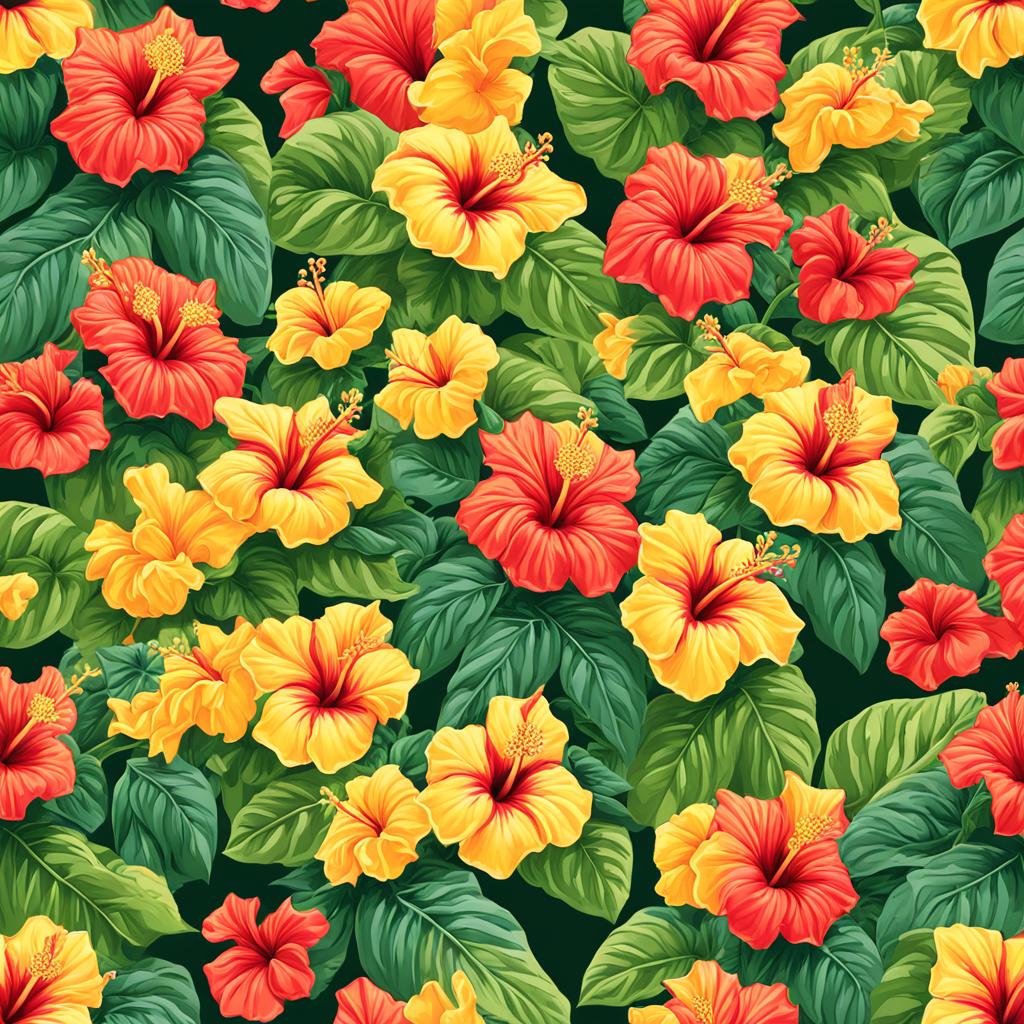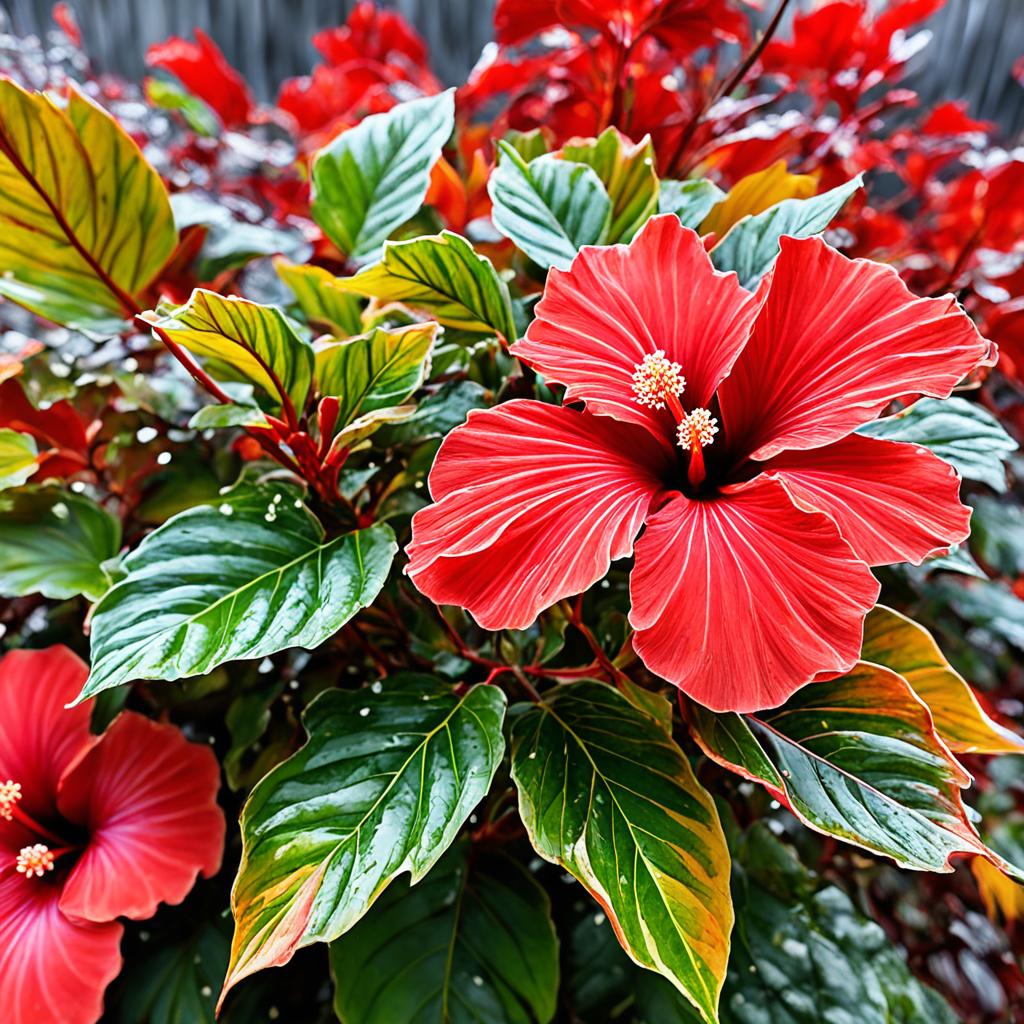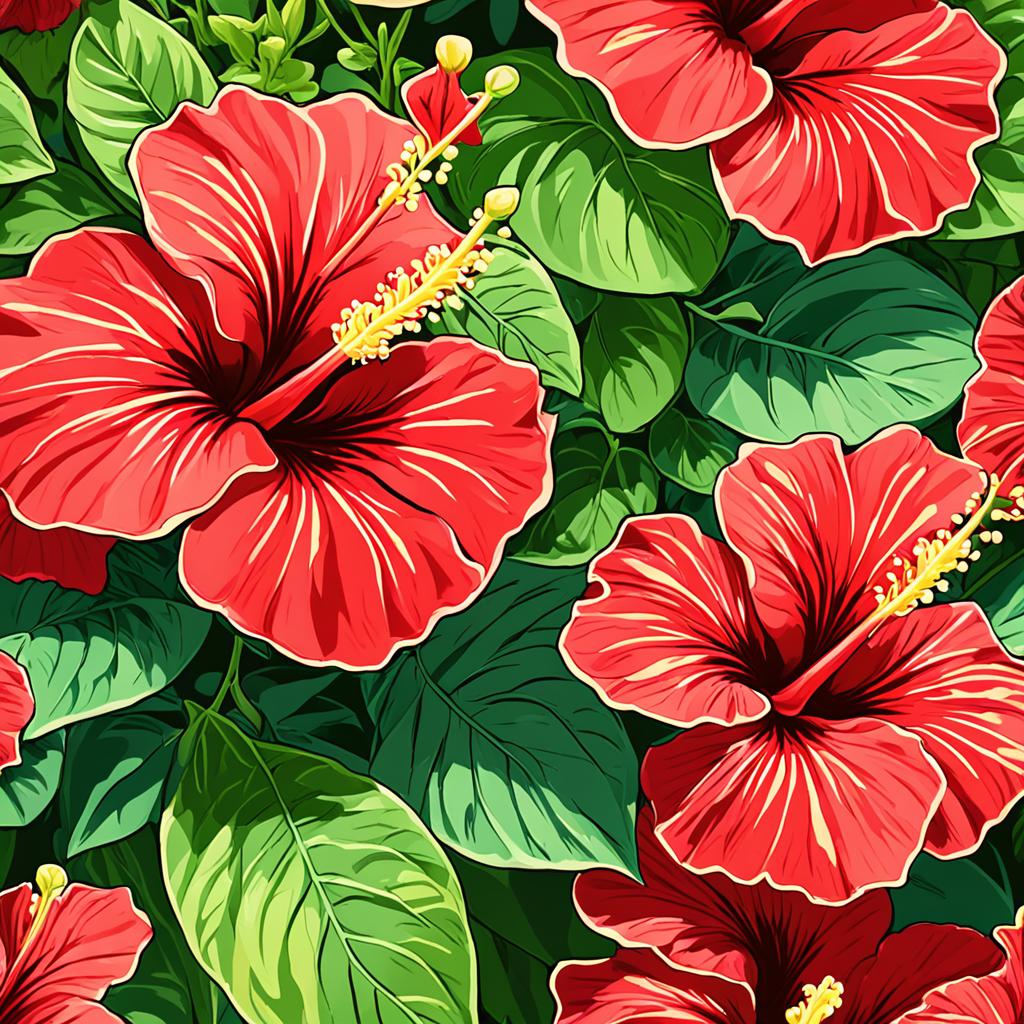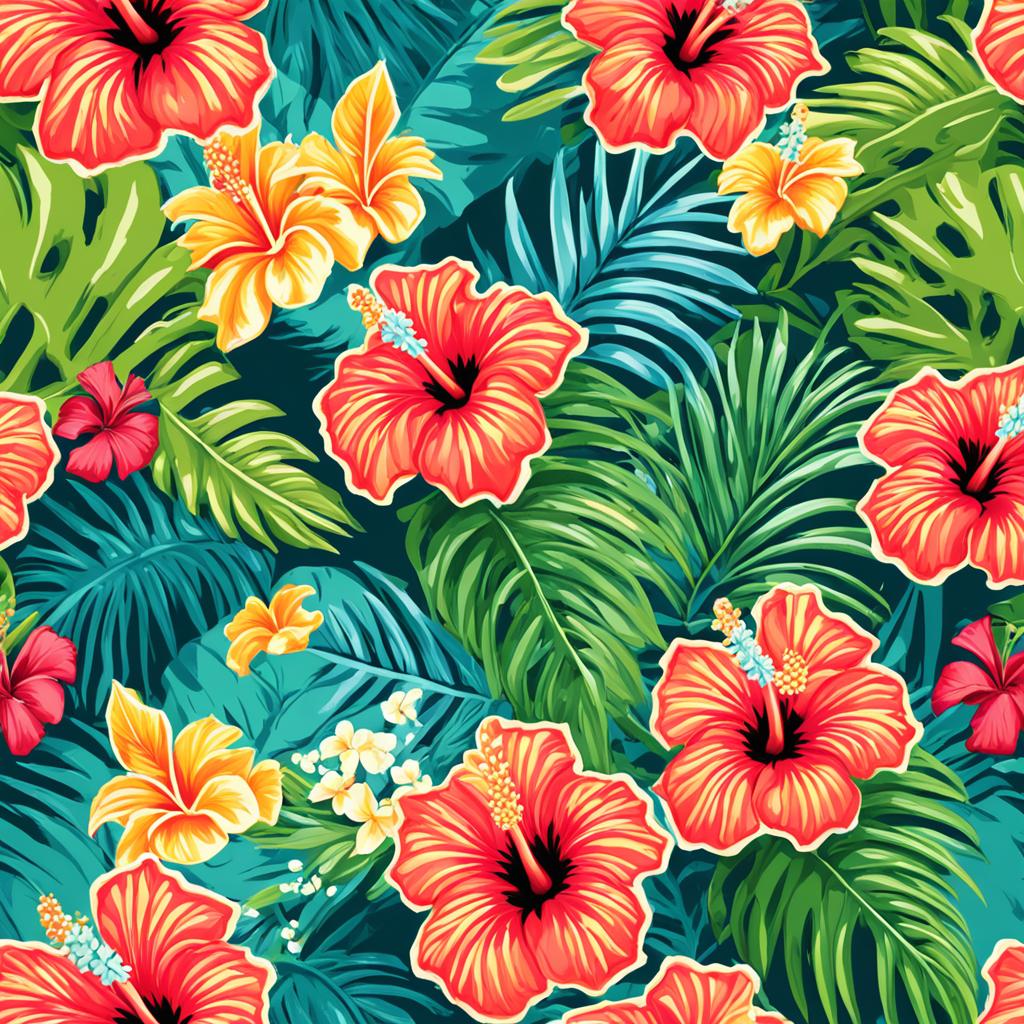When it comes to creating a stunning and resilient garden, the Hawaiian Punch Hibiscus is a popular choice. With its vibrant blooms and tropical charm, this variety adds a touch of exotic beauty to any landscape. But is it truly a hardy plant that can withstand harsh weather conditions?
Contrary to popular belief, the Hawaiian Punch Hibiscus is not a hardy plant. While it thrives in warm climates and offers long-lasting blooms, it is not able to survive frost. This means that if you live in a cooler climate, you’ll need to take extra care to ensure its survival.
But don’t worry, there are still ways to enjoy the beauty of the Hawaiian Punch Hibiscus in your garden. In this article, we will explore the care requirements and growing conditions of this stunning plant. We’ll also share tips on overwintering and propagation, as well as common issues and pests to watch out for.
So, if you’re ready to learn how to cultivate and care for this tropical gem, read on to discover everything you need to know about the Hawaiian Punch Hibiscus.
Features and Care Information of Hawaiian Punch Hibiscus

Hawaiian Punch Hibiscus plants offer a stunning array of big, bold, and vibrant blooms that are sure to capture your attention. Unlike most hibiscus varieties that only bloom for a single day, these exceptional plants provide longer-lasting tropical colors that can brighten up your garden or container for 3 to 4 days.
These gorgeous plants are perfect for adding a touch of the tropics to your outdoor spaces. Whether you place them in containers or integrate them into your landscape, you’ll create a vibrant and exotic atmosphere that will turn heads.
To ensure the best care for your Hawaiian Punch Hibiscus, it’s essential to provide them with the right conditions. These plants thrive in full sun, so make sure they receive at least 6 hours of direct sunlight each day. Additionally, they require watering when the top 2.5 cm (1 inch) of soil becomes dry.
For optimal growth and blooming, regular fertilization is key. We recommend using a balanced liquid fertilizer every 2 weeks to provide your Hawaiian Punch Hibiscus with the necessary nutrients. Deadheading spent flowers and seed pods will also promote continuous blooming, ensuring a stunning display of color throughout the growing season.
Aside from their remarkable beauty, Hawaiian Punch Hibiscus plants also attract enchanting visitors to your garden. Butterflies and hummingbirds are drawn to the nectar-rich blooms, transforming your outdoor space into a lively and magical haven for these delightful creatures.
Overall, Hawaiian Punch Hibiscus plants are a captivating addition to any garden or container. With their long-lasting blooms, easy care requirements, and their ability to attract beautiful wildlife, these plants are sure to bring joy and vibrancy to your outdoor oasis.
Growing Conditions for Hawaiian Punch Hibiscus
Hawaiian Punch Hibiscus plants are vibrant and beautiful additions to any garden. To ensure the successful growth of these tropical plants, it’s essential to provide them with the right growing conditions.
Light: Hawaiian Punch Hibiscus plants thrive in full sun. They require a minimum of 6 hours of direct sunlight per day to bloom and grow to their full potential.
Soil: These plants prefer well-drained soil that is rich in organic matter. Good drainage is crucial to prevent the roots from becoming waterlogged, which can lead to root rot.
Water: It’s important to water Hawaiian Punch Hibiscus plants regularly, especially during dry periods. Water the plants when the top layer of soil becomes dry to the touch. Avoid overwatering, as it can cause root rot.
Size and Bloom Colors: Hawaiian Punch Hibiscus plants can grow up to 38-50 cm (15-20 inches) in height. They come in a variety of vibrant bloom colors, including pink, red, orange, yellow, orange-yellow, and white.
| Growing Conditions for Hawaiian Punch Hibiscus | Description |
|---|---|
| Light | Requires a minimum of 6 hours of direct sunlight per day |
| Soil | Well-drained soil rich in organic matter |
| Water | Water when the top layer of soil becomes dry |
| Size and Bloom Colors | Grows up to 38-50 cm (15-20 inches) in height. Comes in various vibrant colors. |
In colder climates, Hawaiian Punch Hibiscus plants are not hardy and should be treated as annuals or brought indoors during frosty periods to protect them from extreme cold temperatures.
Pruning can help maintain the shape of the plants and encourage fuller growth. Regular pruning of spent blooms also promotes continuous blooming throughout the growing season.
By providing the right growing conditions, including ample sunlight, well-drained soil, and proper watering, you can enjoy the vibrant beauty of Hawaiian Punch Hibiscus plants in your garden.
Overwintering and Propagation of Hawaiian Punch Hibiscus

In colder climates, Hawaiian Punch Hibiscus plants cannot survive frost and should be treated as annuals. However, they can be overwintered indoors to protect them from the cold. Ideally, the plants should receive 2-3 hours of direct sunlight daily and require less water during the winter months. Regular misting can help combat dry indoor heat.
Propagation of Hawaiian Punch Hibiscus can be done through soft-stem cuttings taken in late spring or early summer. The cuttings should be dipped in a rooting hormone and planted in a well-draining soil mix.
By overwintering your Hawaiian Punch Hibiscus plants, you can protect them from harsh winter conditions and enjoy their vibrant blooms for another season. To do this, bring the plants indoors before the first frost and place them in a well-lit area, such as a south-facing window. Positioning the plants where they receive 2-3 hours of direct sunlight daily will help them maintain their health and vigor.
During the winter months, Hawaiian Punch Hibiscus plants require less water compared to their active growing season. Allow the top layer of soil to dry out between waterings, and be cautious not to overwater, as excess moisture can cause root rot. Additionally, misting the leaves regularly can help increase humidity and prevent the dry indoor heat from dehydrating the plants.
Propagation is another way to expand your collection of Hawaiian Punch Hibiscus plants. Soft-stem cuttings taken in late spring or early summer have a high success rate for rooting. To propagate, select a healthy stem and make a clean cut just below a set of leaves. Dip the cut end in a rooting hormone to promote root development, then plant the cutting in a well-draining soil mix. Keep the soil lightly moist and provide the cutting with bright, indirect light until new growth emerges.
Tips for Growing Hawaiian Punch Hibiscus

To ensure successful growth of Hawaiian Punch Hibiscus, follow these helpful tips:
- Soil: Use a potting mix specifically formulated for tropical plants, if growing Hawaiian Punch Hibiscus in a container. For plants in the ground, ensure the soil has ample organic matter and good drainage.
- Watering: The watering requirements of Hawaiian Punch Hibiscus may vary depending on environmental conditions. Generally, aim to provide about 1-2 inches of water per week. Monitor the moisture levels and avoid overwatering to prevent root rot.
- Temperature: Hawaiian Punch Hibiscus thrives in average temperatures between 55 and 70 degrees Fahrenheit. Protect the plants from extreme heat or frost to maintain their health and vigor.
- Fertilization: After the initial slow-release fertilizer charge, regularly feed Hawaiian Punch Hibiscus with a diluted fish emulsion fertilizer. This will provide the necessary nutrients for optimum growth and blooming.
- Pruning and Repotting: Prune the plants regularly to maintain their shape and promote fuller growth. If growing in a container, consider repotting when the plant outgrows its current pot size. Use the right container shape and material to ensure proper drainage and airflow.
By following these tips, you can ensure that your Hawaiian Punch Hibiscus plants thrive and reward you with vibrant tropical blooms.
Common Issues and Pests for Hawaiian Punch Hibiscus
Dropping leaves, stress, and poor growth in Hawaiian Punch Hibiscus plants can be attributed to various factors. One common issue is the need for repotting. As these plants grow, they may outgrow their current containers, leading to restricted root growth and nutrient deficiencies. Inadequate pot size can also cause overheating, especially when exposed to temperatures over 85 degrees Fahrenheit. To ensure optimal growth, consider repotting your Hawaiian Punch Hibiscus in a larger container.
Another issue to watch out for is underwatering or overwatering. Yellowing leaves can indicate both problems, so it’s important to strike a balance when watering your plants. Hawaiian Punch Hibiscus plants typically prefer moist soil but should not be waterlogged. Ensure proper drainage to prevent water from accumulating around the roots.
While Hawaiian Punch Hibiscus plants are generally resilient to pests and diseases, they can still face some challenges, especially when brought indoors. Spider mites and aphids can infest the foliage, sucking sap and causing damage. Regular inspections of the leaves and stems can help detect these pests early. Additionally, bacterial diseases can affect the overall health of the plants. Proper watering practices, adequate sunlight, and appropriate treatment can help mitigate the impact of common issues and pests on your Hawaiian Punch Hibiscus plants.
FAQ
Q: Is the Hawaiian Punch Hibiscus hardy?
A: No, the Hawaiian Punch Hibiscus is not hardy and cannot survive frost. In colder climates, it should be treated as an annual or overwintered indoors.
Q: What are the features and care information of the Hawaiian Punch Hibiscus?
A: The Hawaiian Punch Hibiscus is known for its big, bold, and vibrant blooms that can last for 3 to 4 days. These plants require at least 6 hours of direct sunlight per day and should be watered when the top layer of soil becomes dry. Regular fertilization with a balanced liquid fertilizer every 2 weeks is recommended for optimum growth and blooming.
Q: What are the growing conditions for the Hawaiian Punch Hibiscus?
A: The Hawaiian Punch Hibiscus thrives in full sun and requires a minimum of 6 hours of direct sunlight per day. It prefers well-drained soil and should be watered when the top layer of soil becomes dry. These plants can grow up to 38-50 cm (15-20 inches) in height and come in various bloom colors. In colder climates, they should be treated as annuals or brought indoors during frosty periods.
Q: How can I overwinter and propagate the Hawaiian Punch Hibiscus?
A: In colder climates, the Hawaiian Punch Hibiscus cannot survive frost and should be treated as an annual. However, it can be overwintered indoors to protect it from the cold. The plants should receive 2-3 hours of direct sunlight daily and require less water during the winter months. Propagation can be done through soft-stem cuttings taken in late spring or early summer. The cuttings should be dipped in a rooting hormone and planted in a well-draining soil mix.
Q: What are some tips for growing the Hawaiian Punch Hibiscus?
A: To ensure successful growth, use a potting mix formulated for tropical plants if growing in a container. In the ground, the soil should have ample organic matter and good drainage. Watering requirements may vary, but typically the plants need about 1-2 inches of water per week. Proper temperature is important, with average temperatures between 55 and 70 degrees Fahrenheit being ideal. Regular feeding with a diluted fish emulsion fertilizer is recommended. Pruning, repotting, and using the right container shape and material are also essential for maintaining healthy plants.
Q: What are the common issues and pests for the Hawaiian Punch Hibiscus?
A: Common issues may include dropping leaves, stress, and poor growth, which can be attributed to various factors. Yellowing leaves can indicate either underwatering or overwatering. While these plants are generally free of pests and diseases, common issues may include spider mites and aphids, especially when plants are brought indoors. Bacterial diseases can also affect these plants. Regular inspection, proper watering, and appropriate treatment can help mitigate these issues.
